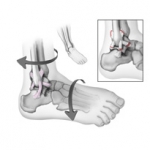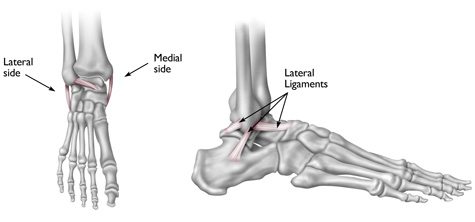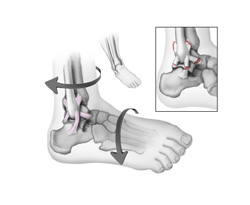 The most common of sporting injuries is the ankle sprain. Our podiatrist explores what actually happens when an ankle is sprained.
The most common of sporting injuries is the ankle sprain. Our podiatrist explores what actually happens when an ankle is sprained.
Ankle sprains are an injury to one or more of the many ligaments of the ankle. Ligaments are bands of strong, fibrous tissue that attach from one bone to another across joints. They prevent excessive or incorrect movement at the joints and they keep joints stable and in correct alignment.
A sprain occurs when the ligaments are stretched beyond physical limits. Damage to the ligament fibers and cells follows and the ligaments will stretch and tear.
When people talk about ankle sprains, they are generally talking about a sprain to any of the ligaments that protect the ankle and the middle part of the foot. Strictly speaking the ankle joint is the joint between the foot and the leg bones, and where the foot moves up and down ( point and flex). The joints siting under the ankle joint allow the twisting and turning of the foot. The most commonly injured ligaments are the outside (lateral) ankle ligaments which control the twisting of the foot inwards. The other major ligament complexes at on the inside (medial) of the ankle, outside at the middle/top ( lateral/ dorsal) of the foot and between the long bones of the leg just above the ankle ( syndesmosis).
Treatment for a ankle sprain will depend on which ligaments are involved and how bad the injury is. Ankle sprains are “graded” by the severity of the damage. The mildest sprain is a grade 1 and the most severe is a grade 3.
Grade 1 Sprain
• Minimal level of damage
• Slight stretching and microscopic tearing of the ligament fibers
• Mild tenderness and swelling around the ankle
• Joint structure is secure
Grade 2 Sprain
• Moderate level of damage
• Partial tearing of the ligament
• Moderate tenderness and swelling around the ankle
• Abnormal looseness of the joint with certain movements
Grade 3 Sprain 
• Severe damage
• Complete tear of the ligament
• Significant tenderness and swelling around the ankle
• Substantial instability and excessive movement occurs with certain movements
In our next post we will look at what to do when you have an ankle sprain.
All images are from aoos.org


